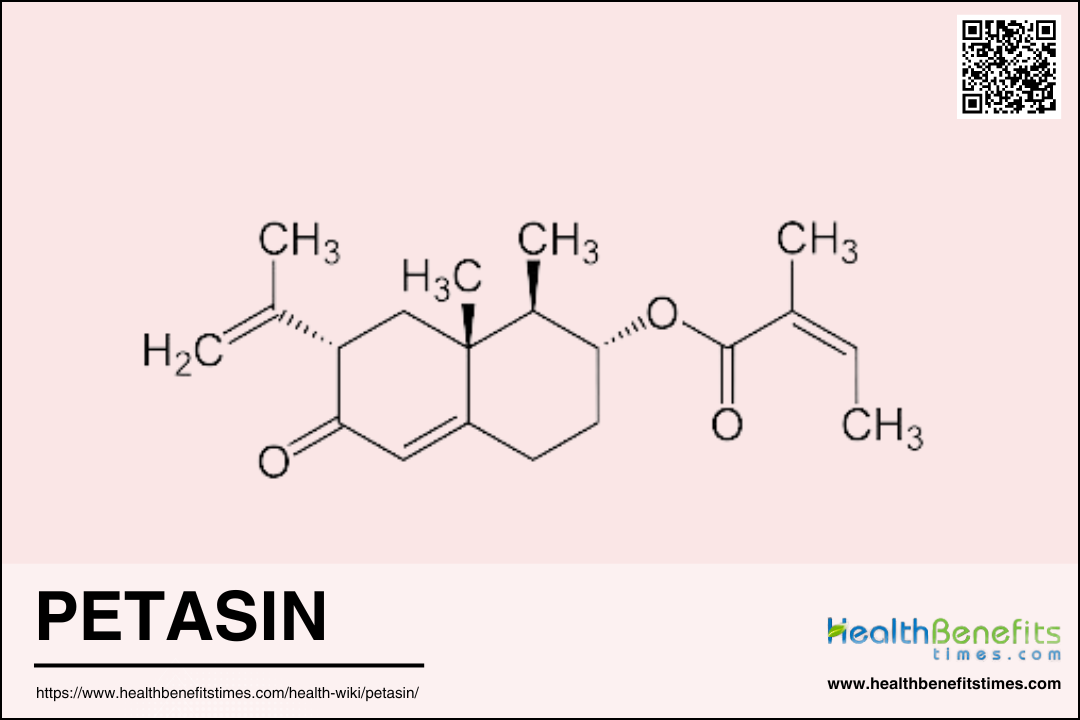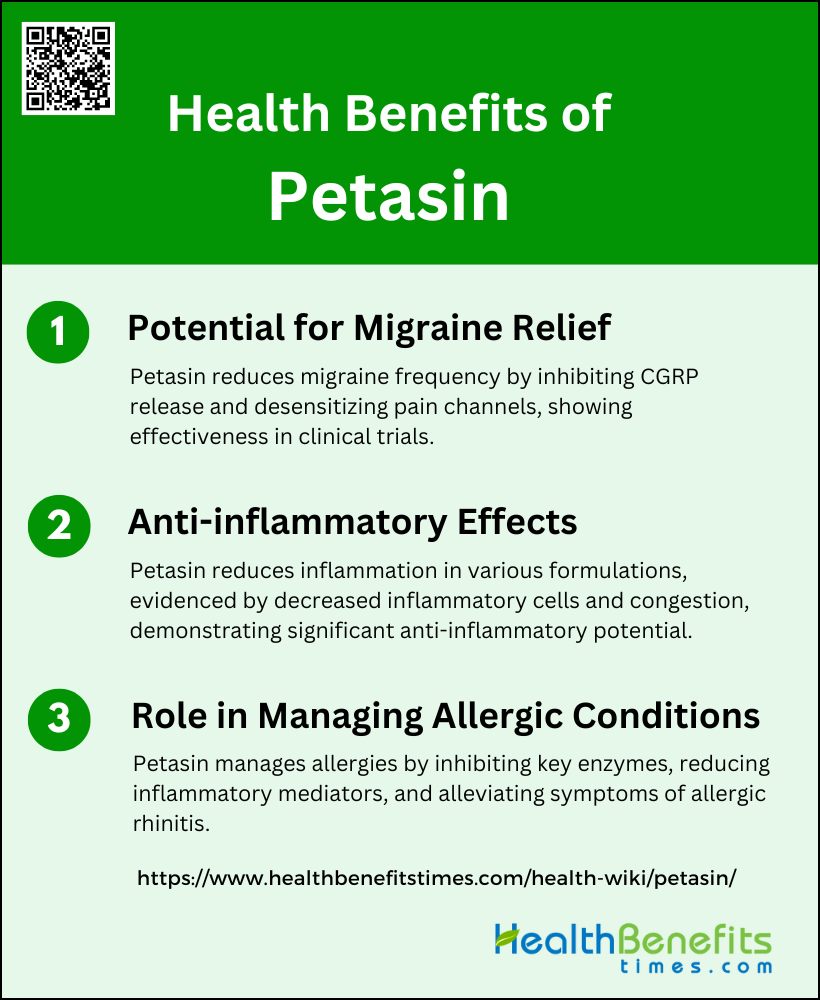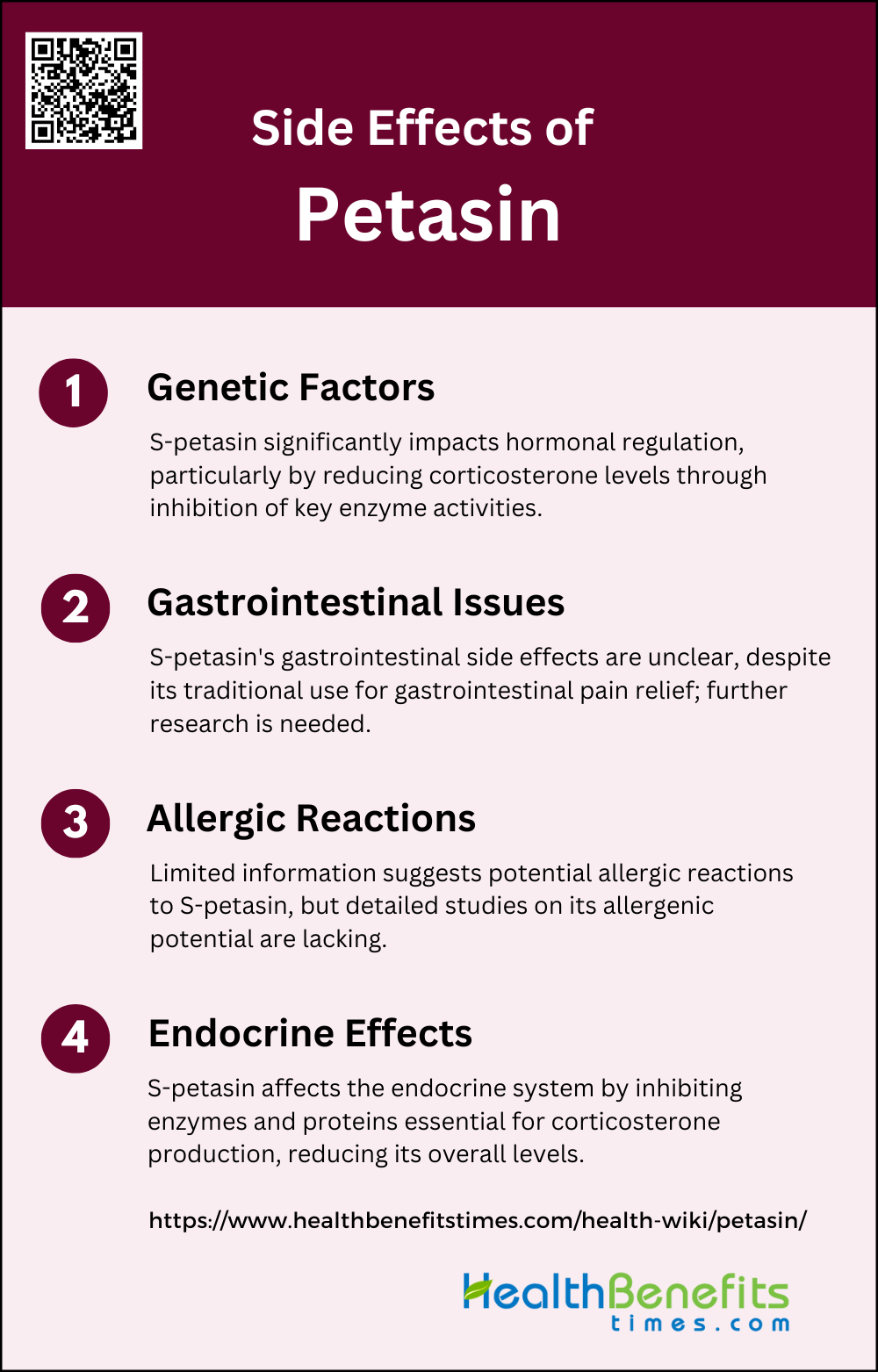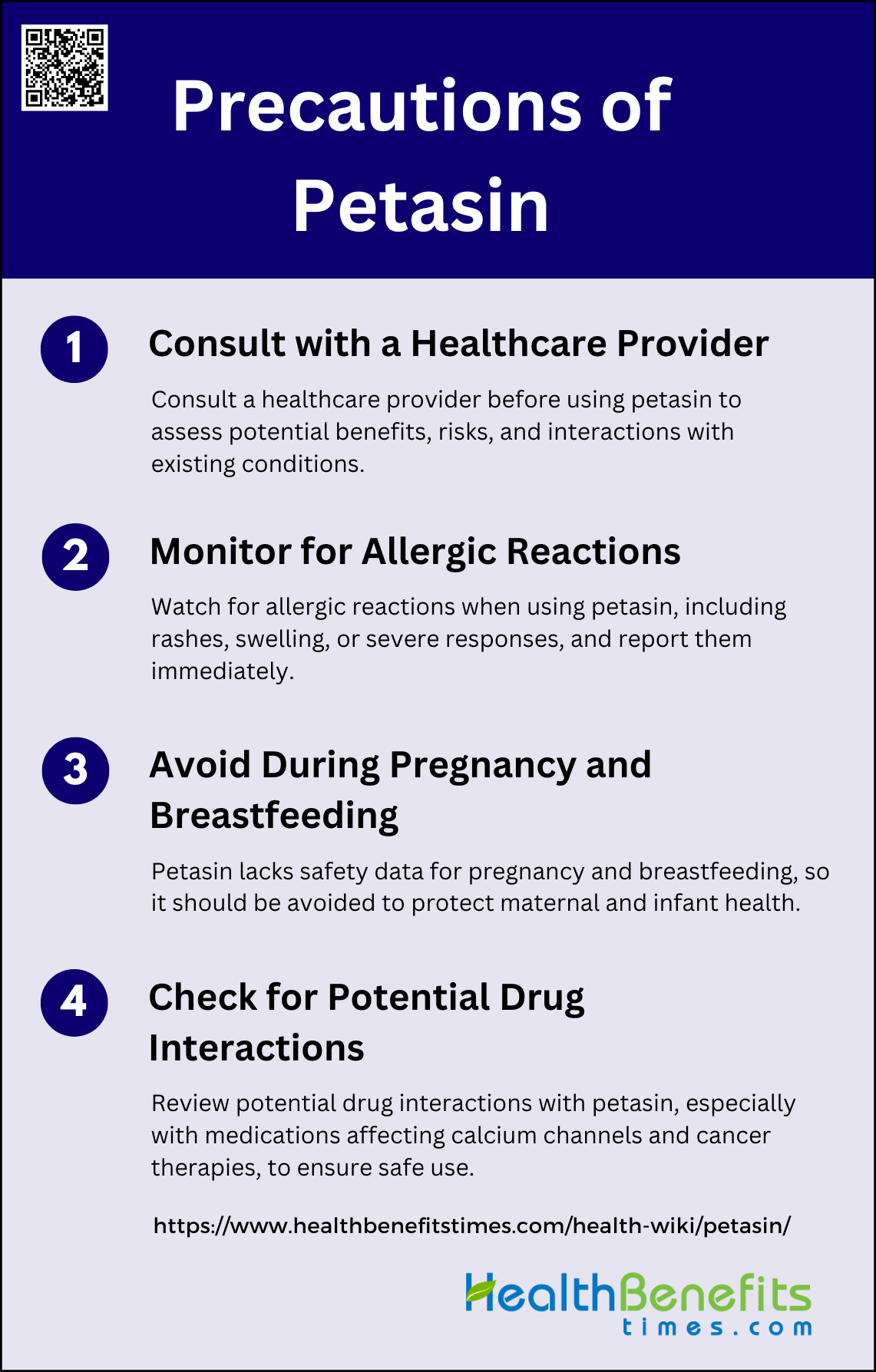Petasin is a naturally occurring compound found in the butterbur plant (Petasites hybridus). It has been studied for its potential medicinal properties, particularly in the treatment of migraines and other types of headaches. Petasin is believed to work by inhibiting the production of leukotrienes, which are inflammatory substances that can contribute to the development of migraines. Some research suggests that petasin may also have antispasmodic effects, potentially helping to relax smooth muscle tissues and reduce muscle spasms. However, more research is needed to fully understand the efficacy and safety of petasin for various health conditions.
Chemical structure and properties of Petasin
Its chemical structure is characterized by an angular methyl group, which has been confirmed through rotatory dispersion analysis to align with the configuration of eremophilone and its related compounds. Petasin exhibits significant biological activity, notably as a potent inhibitor of mitochondrial electron transport chain complex I (ETCC1), which is crucial for cancer metabolism. This inhibition leads to reduced tumor growth and metastasis without apparent toxicity to normal cells. Additionally, petasin and its isomers, such as isopetasin, have been shown to relax precontractions in isolated guinea pig trachealis, with sulfur-containing derivatives like S-petasin demonstrating higher potency. The compound’s ability to inhibit peptido-leukotriene biosynthesis further contributes to its medicinal properties, including gastroprotection and spasmolytic activity.
Natural sources of petasin
Extracted mainly from the butterbur plant (Petasites hybridus), petasin has been traditionally used in herbal medicine to treat migraines, allergies, and other ailments. Below is a list of natural sources where petasin can be found:
1. Petasites hybridus
The leaves, roots, and rhizomes of this plant contain petasin and related compounds. Butterbur has been used in traditional medicine to treat various ailments, including migraines, asthma, and stomach ulcers. However, unprocessed butterbur may contain pyrrolizidine alkaloids, which can be toxic to the liver. Therefore, it is essential to use only properly prepared and purified butterbur extracts that are free of these harmful compounds.
2. Petasites japonicus
Petasites japonicus, also known as Japanese butterbur or fuki, is a species of butterbur native to Japan, Korea, and parts of China. Like Petasites hybridus, this plant contains petasin and other related compounds in its leaves, roots, and rhizomes. Petasites japonicus has been used in traditional Asian medicine to treat various conditions, including headaches, inflammation, and respiratory disorders. However, more research is needed to confirm the efficacy and safety of using this plant for medicinal purposes.
3. Ligularia fischeri
Ligularia fischeri, also known as bear’s breeches or fuki-no-tō, is a perennial plant native to East Asia. While not a true butterbur, this plant also contains petasin and related compounds in its leaves and rhizomes. Ligularia fischeri has been used in traditional Korean and Chinese medicine to treat various ailments, including inflammation, pain, and respiratory disorders. However, like Petasites species, Ligularia fischeri may contain pyrrolizidine alkaloids, which can be toxic to the liver. Caution is advised when using this plant for medicinal purposes.
How Petasin Works
Petasin is a bioactive compound found in certain plants, known for its anti-inflammatory and antispasmodic properties. It works by inhibiting leukotriene synthesis, which helps reduce inflammation and muscle spasms. Below are some natural sources of petasin:
1. Mechanism of Action in the Body
Petasin, a sesquiterpene found in plants of the genus Petasites, exhibits multiple mechanisms of action in the body. Primarily, petasin has been shown to activate AMP-activated protein kinase (AMPK), which plays a crucial role in modulating glucose metabolism. This activation occurs through the inhibition of mitochondrial respiratory chain complex I, leading to an increased intracellular AMP/ATP ratio. Additionally, petasin demonstrates significant relaxant effects on smooth muscle tissues. It non-competitively inhibits histamine- and carbachol-induced contractions in guinea pig trachea, suggesting antispasmodic and antimuscarinic properties. Furthermore, petasin reduces calcium influx into vascular smooth muscle cells by inhibiting L-type voltage-dependent calcium channels (VDCC), contributing to its hypotensive effects.
2. Comparison with Other Similar Compounds
When compared to other similar compounds, petasin exhibits unique and multifaceted pharmacological activities. For instance, while zileuton, a 5-lipoxygenase inhibitor, primarily inhibits leukotriene synthesis, petasin not only inhibits leukotriene synthesis but also blocks early signaling events initiated by G protein-coupled receptors in granulocytes, affecting calcium fluxes and subsequent leukotriene generation. Additionally, unlike many other antispasmodic agents that target specific pathways, petasin’s relaxant effects are broad, affecting both cAMP-dependent and calcium-dependent pathways. This multifaceted approach makes petasin a versatile compound with potential applications in treating various conditions, including metabolic diseases, hypertension, and inflammatory responses.
Health Benefits of Petasin
Petasin offers various health benefits due to its anti-inflammatory and antispasmodic properties. It is particularly effective in managing migraines, allergies, and gastrointestinal disorders. Below are some natural sources of petasin:
1. Potential for Migraine Relief
Petasin, a pharmacologically active ingredient of butterbur, has shown significant potential in the prevention and treatment of migraines. Studies have demonstrated that petasin can reduce the frequency of migraine attacks by inhibiting the release of calcitonin-gene related peptide (CGRP) from meningeal afferents, which is a key factor in migraine pathophysiology. Additionally, petasin desensitizes nociception by acting on TRPA1 and TRPPV1 ion channels, thereby dampening pain signals. Clinical trials with Petadolex, a butterbur root extract, have reported a significant reduction in migraine attack frequency at a dosage of 150 mg/day, with no relevant abnormal liver function observed.
2. Anti-inflammatory Effects
Petasin also exhibits notable anti-inflammatory properties, which have been explored in various formulations. In a study involving a zinc oxide eugenol (ZnOE) sealer modified with petasin, it was found that the addition of petasin significantly reduced inflammation. The study, conducted on zebrafish, showed that ZnOE sealer containing eugenol and petasin in a 1:1 ratio resulted in the maximal reduction of inflammation. This was evidenced by a decrease in the presence of inflammatory cells and congestion of arterioles. These findings suggest that petasin can effectively mitigate the inflammatory potential of ZnOE sealers, highlighting its broader anti-inflammatory efficacy.
3. Role in Managing Allergic Conditions
Petasin has also been recognized for its role in managing allergic conditions, particularly allergic rhinitis. Its anti-inflammatory properties contribute to its effectiveness in reducing symptoms associated with allergies. By inhibiting the activities of cyclooxygenases, lipoxygenases, and phospholipase A2, petasin diminishes the production of inflammatory mediators, which are often elevated in allergic responses. This mechanism of action not only helps in alleviating the symptoms of allergic rhinitis but also underscores the therapeutic versatility of petasin in managing various inflammatory and allergic conditions.
Uses of Petasin in Medicine
Overview of Current Medical Uses
Petasin, a natural product found in plants of the genus Petasites, has been utilized in traditional and modern medicine for various therapeutic purposes. It is primarily known for its antimigraine and antiallergy activities, with extracts from Petasites hybridus (butterbur) being used to treat conditions such as asthma, allergic rhinitis, and migraines. Additionally, S-petasin, a sesquiterpene from Petasites formosanus, has been employed in Taiwan to manage hypertension, tumors, and asthma. The compound has also shown potential in modulating glucose metabolism and activating AMP-activated protein kinase (AMPK), suggesting its use in treating metabolic diseases.
Research and Studies on Petasin’s Effectiveness
Numerous studies have investigated the pharmacological effects of petasin. For instance, petasin has been shown to inhibit leukotriene synthesis in leukocytes, which is beneficial in treating allergic diseases. In preclinical studies, S-petasin demonstrated significant inhibition of phosphodiesterase activities, reducing airway hyperresponsiveness in asthma models. Additionally, petasin has been found to activate AMPK, enhancing glucose tolerance and modulating glucose metabolism in mice. Clinical trials have also indicated that butterbur extracts containing petasin are as effective as antihistamines in reducing symptoms of allergic rhinitis without significant side effects.
Potential Future Applications
Future applications of petasin could extend beyond its current uses, given its diverse pharmacological properties. Research suggests that petasin could be a potent inhibitor of mitochondrial complex I, showing promise in cancer treatment by suppressing tumor growth and metastasis without apparent toxicity to normal cells. Additionally, its role in modulating glucose metabolism and activating AMPK points to potential applications in managing metabolic disorders such as diabetes. The anti-inflammatory and immunomodulatory effects of petasin also suggest its potential in treating various inflammatory and autoimmune diseases. Further research and clinical trials are needed to fully explore and validate these potential applications.
How to Incorporate Petasin into Your Routine
Suggested supplements and products
Petasin has been studied for its potential anti-inflammatory and analgesic properties. While petasin supplements are available, it’s important to choose products from reputable brands that have been tested for quality and purity. Always consult with a healthcare professional before starting any new supplement regimen.
Natural dietary sources
Butterbur (Petasites hybridus) is the primary natural source of petasin. The leaves and roots of the plant can be consumed, but it’s crucial to ensure they have been properly processed to remove pyrrolizidine alkaloids, which can be toxic to the liver. Consuming butterbur in its natural form is not recommended without guidance from a qualified healthcare provider.
Tips for safe use
When incorporating petasin into your routine, start with the lowest effective dose and gradually increase as needed. Be aware that petasin may interact with certain medications, such as blood thinners and NSAIDs. Discontinue use if any adverse effects occur and consult with a healthcare professional. Petasin should not be used by pregnant or breastfeeding women, children, or individuals with liver or kidney disease.
Side Effects of petasin
Petasin is known for its potential therapeutic benefits. However, like many natural compounds, it may also cause a range of side effects. Below are some of the possible side effects associated with petasin use:
1. Hormonal Changes
S-petasin, a bioactive compound from Petasites hybridus, has been shown to significantly impact hormonal regulation, particularly corticosterone release. Research indicates that S-petasin decreases both basal and adrenocorticotropin (ACTH)-induced plasma corticosterone concentrations in male rats. This effect is observed both in vivo and in vitro, where S-petasin reduces corticosterone release from rat zona fasciculata-reticularis (ZFR) cells in a dose-dependent manner. The mechanism involves the inhibition of adenylyl cyclase activity, which subsequently reduces cyclic AMP (cAMP) production, a crucial secondary messenger in hormone signaling pathways.
2. Gastrointestinal Issues
S-petasin has been traditionally used to alleviate gastrointestinal pain, suggesting its potential therapeutic benefits. However, the specific side effects related to gastrointestinal health are not well-documented in the current literature. While its primary use in herbal medicine is to relieve gastrointestinal discomfort, further studies are needed to comprehensively understand any adverse gastrointestinal effects that may arise from its use. The existing research primarily focuses on its endocrine effects rather than direct gastrointestinal side effects.
3. Allergic Reactions
There is limited information available on allergic reactions specifically caused by S-petasin. Given that Petasites hybridus, the plant from which S-petasin is derived, is used in traditional medicine, it is possible that some individuals may experience allergic reactions. These could manifest as skin rashes, itching, or other hypersensitivity responses. However, detailed studies focusing on the allergenic potential of S-petasin are lacking, and more research is needed to identify and characterize any allergic reactions associated with its use.
4. Endocrine Effects
S-petasin has notable endocrine effects, particularly on the adrenal cortex. It inhibits the production of corticosterone by decreasing the activities of key enzymes such as P450scc and 11beta-hydroxylase. Additionally, S-petasin reduces the expression levels and mRNA of steroidogenic acute regulatory protein, which is essential for steroid hormone biosynthesis. These actions collectively result in a significant reduction in corticosterone production, highlighting S-petasin’s potential impact on the endocrine system and its regulatory mechanisms.
Precautions of petasin
While petasin, a compound derived from the butterbur plant, offers potential therapeutic benefits, it is essential to take certain precautions when using it. Below are some key precautions to consider to ensure safe and effective use of petasin.
1. Consult with a Healthcare Provider
Before starting any treatment involving petasin, it is crucial to consult with a healthcare provider. Petasin, a compound found in the medicinal plant Petasites formosanus, has shown significant biological activity, including hypotensive effects and anticancer properties. However, its interactions with other medications and its effects on various health conditions are not fully understood. A healthcare provider can help assess the potential benefits and risks based on individual health profiles and existing medical conditions. This step ensures that the use of petasin is safe and appropriate for the patient’s specific health needs.
2. Monitor for Allergic Reactions
Monitoring for allergic reactions is essential when using petasin. As with any natural product, there is a risk of allergic responses, which can range from mild skin irritations to severe anaphylactic reactions. Although studies have primarily focused on its hypotensive and anticancer effects, the potential for allergic reactions remains. Symptoms such as rash, itching, swelling, dizziness, or difficulty breathing should be promptly reported to a healthcare provider. Early detection and management of allergic reactions can prevent serious health complications and ensure safe use of petasin.
3. Avoid During Pregnancy and Breastfeeding
Petasin should be avoided during pregnancy and breastfeeding due to the lack of comprehensive safety data. While research has demonstrated its hypotensive and anticancer properties, the effects of petasin on fetal development and infant health are not well-studied. The potential risks to the developing fetus or nursing infant outweigh the benefits, making it prudent to avoid petasin during these critical periods. Pregnant and breastfeeding women should seek alternative treatments that have established safety profiles to protect their health and that of their children.
4. Check for Potential Drug Interactions
Checking for potential drug interactions is vital when considering petasin as a treatment option. Petasin has been shown to affect calcium channels and the Akt/mTOR pathway, which could interact with other medications that influence these pathways. For instance, combining petasin with other hypotensive drugs or cancer therapies could lead to unexpected side effects or diminished efficacy. A healthcare provider can review all current medications and supplements to identify any possible interactions, ensuring that petasin can be used safely and effectively without compromising other treatments.
Petasin Comparison with Other Natural Remedies
Petasin versus Butterbur
Petasin is a pharmacologically active compound found in butterbur (Petasites hybridus) and is primarily responsible for its therapeutic effects, particularly in the treatment of migraines and tension headaches. Butterbur extracts, such as Petadolex, have been shown to reduce migraine attack frequency by inhibiting the release of calcitonin-gene related peptide (CGRP) and desensitizing nociception through TRP ion channels. However, butterbur also contains hepatotoxic pyrrolizidine alkaloids (PAs), which limit its direct usage due to potential liver toxicity. Therefore, while petasin contributes significantly to butterbur’s efficacy, the presence of PAs necessitates careful consideration of safety and dosage.
Petasin Compared to Other Herbal Supplements
When compared to other herbal supplements used for migraine prophylaxis, such as feverfew, petasin from butterbur stands out due to its specific mechanism of action. Petasin inhibits inflammatory mediators and desensitizes nociception, which is crucial for migraine prevention. Other herbal supplements like feverfew also show efficacy but through different pathways, such as inhibiting serotonin release and reducing blood vessel reactivity. Additionally, nutraceuticals like magnesium, riboflavin, and coenzyme Q10 are commonly used for migraine prevention, each with their own mechanisms and varying degrees of efficacy and side effects. Thus, petasin offers a unique and effective option among herbal supplements, though it must be used with caution due to potential hepatotoxicity.
Advantages and Disadvantages
The primary advantage of petasin is its effectiveness in reducing migraine frequency by targeting specific pathways involved in migraine pathophysiology, such as CGRP signaling and TRP ion channels. This makes it a potent option for those seeking alternative migraine treatments. However, the major disadvantage lies in the hepatotoxicity associated with butterbur’s pyrrolizidine alkaloids, which can cause liver damage if not properly managed. Additionally, while petasin itself is effective, the overall safety profile of butterbur extracts necessitates careful monitoring and adherence to recommended dosages to avoid adverse effects. Therefore, while petasin offers significant benefits, its use must be balanced with considerations of safety and potential side effects.
FAQs
1. Can Petasin be used in combination with other natural supplements?
Petasin can potentially be used alongside other natural supplements, but it is important to consult with a healthcare provider to avoid any interactions or side effects. Some supplements may interact negatively with petasin, especially if they share similar pathways or mechanisms of action.
2. What are the potential risks of long-term use of Petasin?
Long-term use of petasin may carry risks, particularly concerning liver health due to the presence of pyrrolizidine alkaloids in unpurified butterbur extracts. Even though purified extracts are safer, long-term effects are not fully understood and should be monitored by a healthcare professional.
3. Is Petasin safe for children?
The safety of petasin in children has not been well established. Due to the potential risks, including liver toxicity and hormonal effects, petasin should only be used in children under the guidance of a healthcare provider.
4. What is the recommended dosage of Petasin for migraine prevention?
While some studies suggest dosages of around 50-150 mg of butterbur extract (standardized for petasin content) twice daily for migraine prevention, the exact dosage can vary based on individual health conditions and should be determined by a healthcare provider.
5. Are there any known contraindications for Petasin?
Petasin is contraindicated in individuals with liver disease, pregnant or breastfeeding women, and those with known allergies to butterbur or related plants. It should also be avoided in individuals taking medications that affect the liver or those with certain hormonal disorders.
6. How does Petasin compare with pharmaceutical treatments for migraines?
Petasin offers a natural alternative to pharmaceutical migraine treatments. While it has shown efficacy in reducing migraine frequency, it may not be as potent as some prescription medications and should be considered as part of a broader treatment plan, potentially in combination with pharmaceuticals under medical supervision.
7. Can Petasin be used for conditions other than migraines?
Yes, petasin has shown potential in treating allergic rhinitis, asthma, and other inflammatory conditions. However, its effectiveness and safety in these applications require further research, and its use should be guided by a healthcare provider.
8. What should I do if I experience side effects while taking Petasin?
If you experience side effects such as gastrointestinal discomfort, allergic reactions, or unusual symptoms while taking petasin, you should discontinue use immediately and consult with a healthcare provider for further evaluation and advice.
9. Is Petasin effective for all types of headaches?
Petasin has primarily been studied for its effects on migraines and tension headaches. Its effectiveness for other types of headaches, such as cluster headaches or headaches caused by other underlying conditions, is less clear and may require different treatments.
10. Can I take Petasin if I have a history of allergies?
If you have a history of allergies, especially to plants in the Asteraceae family (which includes butterbur), you should exercise caution when taking petasin and consult with a healthcare provider to assess your risk of an allergic reaction.





